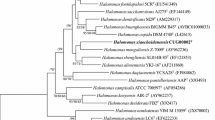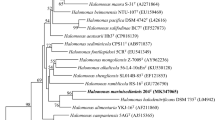Abstract
A Gram-negative, aerobic, short rod-shaped and non-motile bacterium, designated SWA25T, was isolated from Chinese fermented fish sauce in Shantou, Guangdong Province, China. Strain SWA25T was moderately halophilic, formed colourless colonies and grew at 10–45 °C (optimum, 37 °C) and pH 4–9 (optimum, 6–7) in the presence of 0.5–22.5 % (w/v) NaCl (optimum, 3 %). The major cellular fatty acids (>10 %) were identified as C18:1 ω7C, C16:0, C16:1 ω7c, and C19:0 cyclo ω8c, and the predominant respiratory ubiquinone was Q-9. The genomic DNA G+C content was 61.3 ± 2.1 mol %. Phylogenetic analysis based on 16S rRNA gene sequences indicated that strain SWA25T belonged to the genus Halomonas in the family Halomonadaceae. The closest relatives were Halomonas xianhensis A-1T (96.5 % 16S rRNA gene sequence similarity), H. lutea DSM 23508T (96.5 %) and H. muralis LMG 20969T (96.1 %). DNA–DNA hybridization assays showed 30.7 ± 2.6 % relatedness between strain SWA25T and H. xianhensis A-1T, and 39.4 ± 4.1 % between strain SWA25T and H. lutea DSM 23508T. On the basis of phenotypic, chemotaxonomic and phylogenetic features, strain SWA25T should be placed in the genus Halomonas as a representative of a novel species. The name Halomonas shantousis sp. nov. is proposed, with SWA25T(=CCTCC AB 2013151T = JCM 19368T) as the type strain.

Similar content being viewed by others
References
Arahal DR, Ludwig W, Schleifer KH, Ventosa A (2002) Phylogeny of the family Halomonadaceae based on 23S and 16S rDNA sequence analyses. Int J Syst Evol Microbiol 52:241–249
Arahal DR, Vreeland RH, Litchfield CD, Mormile MR, Tindall BJ, Ventosa A (2007) Recommended minimal standards for describing new taxa of the family Halomonadaceae. Int J Syst Evol Microbiol 57:2436–2446
Arenas M, Bañón PI, Copa-Patiño JL, Sánchez-Porro C, Ventosa A, Soliveri J (2009) Halomonas ilicicola sp. nov., a moderately halophilic bacterium isolated from a saltern. Int J Syst Evol Microbiol 59:578–582
Cerny G (1978) Studies on the aminopeptidase test for the distinction of gram-negative from gram-positive bacteria. Eur J Appl Microbiol Biotechnol 5:113–122
Chen C, Shi R, Liu BB, Zhang YJ, Sun HZ, Li CT, Li WJ (2011) Halomonas qijiaojingensis sp. nov. and Halomonas flava sp. nov., two moderately halophilic bacteria isolated from a salt lake. Antonie Van Leeuwenhoek 100:365–373
De Ley J, Cattoir H, Reynaerts A (1970) The quantitative measurement of DNA hybridization from renaturation rates. Eur J Biochem 12:133–142
García MT, Mellado E, Ostos JC, Ventosa A (2004) Halomonas organivorans sp. nov., a moderate halophile able to degrade aromatic compounds. Int J Syst Evol Microbiol 54:1723–1728
Heyrman J, Balcaen A, De Vos P, Swings J (2002) Halomonas muralis sp. nov., isolated from microbial biofilms colonizing the walls and murals of the Saint-Catherine chapel (Castle Herberstein, Austria). Int J Syst Evol Microbiol 52:2049–2054
Huss VA, Festl H, Schleifer KH (1983) Studies on the spectrophotometric determination of DNA hybridization from renaturation rates. Syst Appl Microbiol 4:184–192
Jeong SH, Lee JH, Jung JY, Lee SH, Park MS, Jeon CO (2013) Halomonas cibimaris sp. nov., isolated from jeotgal, a traditional Korean fermented seafood. Antonie Van Leeuwenhoek 103:503–512
Jiang J, Pan Y, Meng L, Hu S, Zhang X, Hu B, Su T (2013) Halomonas zhaodongensis sp. nov., a slightly halophilic bacterium isolated from saline-alkaline soils in Zhaodong, China. Antonie Van Leeuwenhoek 104:685–694
Jin YX, Shi LH, Kawata Y (2013) Metabolomics-based component profiling of Halomonas sp. KM-1 during different growth phases in poly(3-hydroxybutyrate) production. Bioresour Technol 140:73–79
Khunt M, Pandhi N, Rana A (2013) Effect of medium and environmental parameters on lipase production from extreme halophilic isolate Halomonas salina ku-20. J Pure Appl Microbiol 7:625–630
Kim KK, Jin L, Yang HC, Lee SH (2007) Halomonas gomseomensis sp. nov., Halomonas janggokensis sp. nov., Halomonas salaria sp. nov. and Halomonas denitrificans sp. nov., moderately halophilic bacteria isolated from saline water. Int J Syst Evol Microbiol 57:675–681
Kim OS, Cho YJ, Lee K, Yoon SK, Kim M, Na H, Chun J (2012) Introducing EzTaxon: a prokaryotic 16S rRNA Gene sequence database with phylotypes that represent uncultured species. Int J Syst Evol Microbiol 62:716–721
Komagata K, Suzuki KI (1987) Lipid and cell-wall analysis in bacterial systematics. Methods Microbiol 19:161–206
Kshirsagar PR, Kulkarni SO, Nilegaonkar SS, Niveditha M, Kanekar PP (2013) Kinetics and model building for recovery of polyhydroxyalkanoate (PHA) from Halomonas campisalis. Sep Purif Technol 103:151–160
Lányi B (1988) Classical and rapid identification methods for medically important bacteria. In: Colwell RR and Grigorova R(ed) Methods in microbiology, Academic press, New York, p 1–67
Liu WY, Wang J, Yuan M (2011) Halomonas aidingensis sp. nov., a moderately halophilic bacterium isolated from Aiding salt lake in Xinjiang, China. Antonie Van Leeuwenhoek 99:663–670
Long MR, Zhang DF, Yang XY, Zhang XM, Zhang YG, Zhang YM, Li WJ (2013) Halomonas nanhaiensis sp. nov., a halophilic bacterium isolated from a sediment sample from the South China Sea. Antonie Van Leeuwenhoek 103:997–1005
Margesin R, Schinner F (2001) Potential of halotolerant and halophilic microorganisms for biotechnology. Extremophiles 5:73–83
Marmur J (1961) A procedure for the isolation of deoxyribonucleic acid from micro-organisms. J Mol Biol 3:208–218
Marmur J, Doty P (1962) Determination of the base composition of deoxyribonucleic acid from its thermal denaturation temperature. J Mol Biol 5:109–118
Mata JA, Martínez-Cánovas J, Quesada E, Béjar V (2002) A detailed phenotypic characterisation of the type strains of Halomonas species. Syst Appl Microbiol 25:360–375
Pettersson B, de Silva SK, Uhlén M, Priest FG (2000) Bacillus siralis sp. nov., a novel species from silage with a higher order structural attribute in the 16S rRNA genes. Int J Syst Evol Microbiol 50:2181–2187
Poli A, Moriello VS, Esposito E, Lama L, Gambacorta A, Nicolaus B (2004) Exopolysaccharide production by a new Halomonas strain CRSS isolated from saline lake Cape Russell in Antarctica growing on complex and defined media. Biotechnol Lett 26:1635–1638
Reysenbach AL, Longnecker K, Kirshtein J (2000) Novel bacterial and archaeal lineages from an in situ growth chamber deployed at a mid-Atlantic ridge hydrothermal vent. Appl Environ Microbiol 66:3798–3806
Stackebrandt E, Goebel BM (1994) Taxonomic note: a place for DNA–DNA reassociation and 16S rRNA sequence analysis in the present species definition in bacteriology. Int J Syst Bacteriol 44:846–849
Stanier RY, Palleroni NJ, Doudoroff M (1966) The aerobic Pseudomonads a taxonomic study. J Gen Microbiol 43:159–271
Tamura K, Peterson D, Peterson N, Stecher G, Nei M, Kumar S (2011) MEGA5: Molecular evolutionary genetics analysis using maximum likelihood, evolutionary distance, and maximum parsimony methods. Mol Biol Evol 28:2731–2739
Thompson JD, Gibson TJ, Plewniak F, Jeanmougin F, Higgins DG (1997) The CLUSTAL_X windows interface: flexible strategies for multiple sequence alignment aided by quality analysis tools. Nucleic Acids Res 25:4876–4882
Tsitko IV, Zaitsev GM, Lobanok AG, Salkinoja-Salonen MS (1999) Effect of aromatic compounds on cellular fatty acid composition of Rhodococcus opacus. Appl Environ Microbiol 65:853–855
Ventosa A, Nieto JJ (1995) Biotechnological applications and potentialities of halophilic microorganisms. World J Microbiol Biotechnol 11:85–94
Ventosa A, Quesada E, Rodriguez-Valera F, Ruiz-Berraquero F, Ramos-Cormenzana A (1982) Numerical taxonomy of moderately halophilic gram-negative rods. J Gen Microbiol 128:1959–1968
Wang Y, Tang SK, Lou K, Mao PH, Jin X, Jiang CL, Li WJ (2008) Halomonas lutea sp. nov., a moderately halophilic bacterium isolated from a salt lake. Int J Syst Evol Microbiol 58:2065–2069
Wang CY, Wu SJ, Ng CC, Tzeng WS, Shyu YT (2012) Halomonas beimenensis sp. nov., isolated from an abandoned saltern. Int J Syst Evol Microbiol 62:3013–3017
Xu P, Li WJ, Tang SK, Zhang YQ, Chen GZ, Chen HH, Jiang CL (2005) Naxibacter alkalitolerans gen. nov., sp. nov., a novel member of the family ‘Oxalobacteraceae’ isolated from China. Int J Syst Evol Microbiol 55:1149–1153
Yoon JH, Lee KC, Kho YH, Kang KH, Kim CJ, Park YH (2002) Halomonas alimentaria sp. nov., isolated from jeotgal, a traditional Korean fermented seafood. Int J Syst Evol Microbiol 52:123–130
Zhao B, Wang H, Mao X, Li R, Zhang YJ, Tang S, Li WJ (2012) Halomonas xianhensis sp. nov., a moderately halophilic bacterium isolated from a saline soil contaminated with crude oil. Int J Syst Evol Microbiol 62:173–178
Acknowledgments
The research was funded by Natural Science Foundation of China (No.31101330 and 31371731) and Program for Changjiang Scholars and Innovative Research Team in University (PCSIRT 1188).
Author information
Authors and Affiliations
Corresponding author
Electronic supplementary material
Below is the link to the electronic supplementary material.
Rights and permissions
About this article
Cite this article
Jiang, W., Li, C., Xu, B. et al. Halomonas shantousis sp. nov., a novel biogenic amines degrading bacterium isolated from Chinese fermented fish sauce. Antonie van Leeuwenhoek 106, 1073–1080 (2014). https://doi.org/10.1007/s10482-014-0275-4
Received:
Accepted:
Published:
Issue Date:
DOI: https://doi.org/10.1007/s10482-014-0275-4




